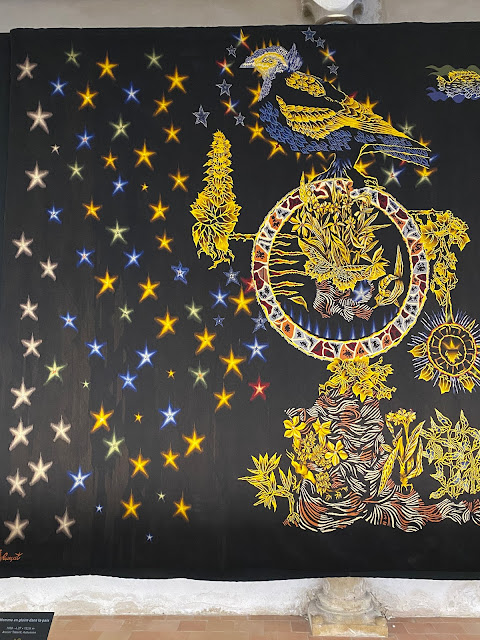Today I'm picking up where I left off last month, talking about my takeaways from the two-week tour of tapestry in France that I was fortunate to take in June. I ended that post with this thought:
For me, the most moving work retains an essential mystery at its core, a stillness. I experienced this when looking at the Lady and the Unicorn, the Apocalypse, and the Song of the World.
 |
| Mon Seul Desir, detail, from The Lady and the Unicorn cycle of tapestries at the Museum of the Middle Ages, (formerly the Cluny) in Paris. (Sorry--photo distorted due to unavoidable camera angle.) |
 |
| Taste, detail from The Lady and the Unicorn at the Museum of the Middle Ages (formerly the Cluny), in Paris |
Ultimately it didn't matter to me what the story was. The lady and her servant stand still, frozen in mid-graceful gesture, enacting a mystery known only to them. The animals seem to know their roles as supporting cast: the lion and unicorn raise the heraldic flags, framing and focusing always on the lady and her servant in the center; the smaller animals cavort amid the flowers. I was enchanted by the gorgeous detail of the millefleurs, the animals and their textured fur, the richly decorated fabrics on the ladies, the still-vibrant color. Stepping into the small-ish dim room where the six large tapestries encircle you is a magical and transporting experience to another world. And isn't that one of the reasons we look at art?
| Touch, detail from the Lady and the Unicorn at the Museum of the Middle Ages (formerly the Cluny), in Paris. |
The narrative behind the mammoth and hugely important Apocalypse tapestry is better known. This series of weavings, over 100 meters long now but even longer when it was woven in the 14th century (much has been lost), is based on the Revelation of John, the last book in the Christian bible, also known as the Apocalypse (the Greek word literally means "revelation" though it has come to be synonymous with the end of the world). It is a mystical vision full of symbol, allegory and human and fantastical creatures engaged in the ultimate battle of good versus evil.
I spent some time at the beginning dutifully consulting my guide, trying to follow the whole epic story, but after awhile I surrendered to just enjoying the details and appreciating the phenomenal weaverly skill involved. These weavers were not reproducing brushstrokes and paint colors from a cartoon; they were weaving the images as they saw fit, exploiting the hatching, hachure, slits and other tools in the weaver's toolbox to create bold woven imagery.
I was particularly interested in a panel depicting a shipwreck. Look at the faces on the poor drowning sailors, each one an individual. Look at the waves--remember these tapestries were woven from the side, so the warp as we see it is running horizontally. Those stripe-y and spiral-y waves were woven as steep verticals.
 |
| Apocalypse, detail, at Angers Chateau |
 |
| Apocalypse, detail, at Anger Chateau |
Notice the hatching on the ground above the waves in the upper right.
 |
| Apocalypse, detail, at Angers Chateau |
In one way, the Apocalypse theme and imagery seem more timely to us than ever. There is so much larger-than-life action here, so much death and destruction on a planetary scale. We are horrified but we can't look away. The theology may be arcane and mysterious but the vision draws us in nonetheless. The making and the survival of this massive cycle of tapestries--which were completed in just ten years--is one of the wonders of the world. It stuns you into silent amazement.
I was similarly awed by Jean Lurçat's twentieth-century Apocalypse, called the Song of the World, which was inspired directly by the medieval one. Lurçat conceived of a cycle that would address humanity's position on the nuclear brink after World War II, depicting both the near-end of life as we know it and the rebirth of life, hope, joy and art. I felt the emotional arc of these tapestries even more keenly than either the Unicorn or the Apocalypse tapestries.
In this panel near the beginning, a human figure guides an ark full of ghostly animals who have been contaminated by radioactive fallout. They are fleeing the nuclear explosion to the left, not seen in this detail.
 |
| Jean Lurçat, detail, The Great Threat from Song of the World |
 | |||
| Jean Lurçat, detail, The Mass Grave, from Song of the World |
 |
| Jean Lurçat, detail from Man in Glory at Peace, from Song of the World |
 |
| Jean Lurçat, detail from Man in Glory at Peace, from Song of the World |
 |
| Jean Lurçat, detail, Champagne, from Song of the World |
Elsewhere in the Song of the World, Lurçat depicts the exploration of space that was happening in the 1960s, when these tapestries were being woven (by workshops in Aubusson, not by Lurçat himself). He clearly had a post-war faith in human technology and in the potential of humans to save themselves from destruction. Sixty-some years later, that faith is harder to hold on to.
For me the privilege of seeing these masterworks of tapestry up close and appreciating their vision and careful craftsmanship is cheering and life-affirming. We wonder sometimes why we bother working in such a time-consuming and misunderstood (or ignored) art form as tapestry. But we can remember that it sometimes it does survive, and it does speak across the decades and maybe even the centuries to viewers like us who long for evidence that we can do great things, one pick at a time.
